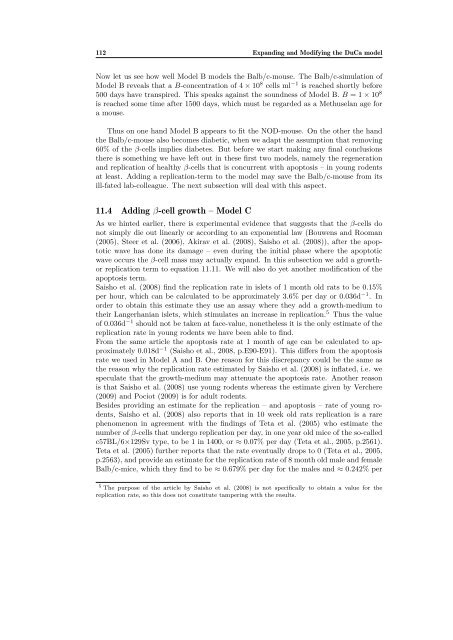nr. 477 - 2011 - Institut for Natur, Systemer og Modeller (NSM)
nr. 477 - 2011 - Institut for Natur, Systemer og Modeller (NSM)
nr. 477 - 2011 - Institut for Natur, Systemer og Modeller (NSM)
Create successful ePaper yourself
Turn your PDF publications into a flip-book with our unique Google optimized e-Paper software.
112 Expanding and Modifying the DuCa model<br />
Now let us see how well Model B models the Balb/c-mouse. The Balb/c-simulation of<br />
Model B reveals that a B-concentration of 4 × 10 8 cells ml −1 is reached shortly be<strong>for</strong>e<br />
500 days have transpired. This speaks against the soundness of Model B. B = 1 × 10 8<br />
is reached some time after 1500 days, which must be regarded as a Methuselan age <strong>for</strong><br />
a mouse.<br />
Thus on one hand Model B appears to fit the NOD-mouse. On the other the hand<br />
the Balb/c-mouse also becomes diabetic, when we adapt the assumption that removing<br />
60% of the β-cells implies diabetes. But be<strong>for</strong>e we start making any final conclusions<br />
there is something we have left out in these first two models, namely the regeneration<br />
and replication of healthy β-cells that is concurrent with apoptosis – in young rodents<br />
at least. Adding a replication-term to the model may save the Balb/c-mouse from its<br />
ill-fated lab-colleague. The next subsection will deal with this aspect.<br />
11.4 Adding β-cell growth – Model C<br />
As we hinted earlier, there is experimental evidence that suggests that the β-cells do<br />
not simply die out linearly or according to an exponential law (Bouwens and Rooman<br />
(2005), Steer et al. (2006), Akirav et al. (2008), Saisho et al. (2008)), after the apoptotic<br />
wave has done its damage – even during the initial phase where the apoptotic<br />
wave occurs the β-cell mass may actually expand. In this subsection we add a growthor<br />
replication term to equation 11.11. We will also do yet another modification of the<br />
apoptosis term.<br />
Saisho et al. (2008) find the replication rate in islets of 1 month old rats to be 0.15%<br />
per hour, which can be calculated to be approximately 3.6% per day or 0.036d −1 . In<br />
order to obtain this estimate they use an assay where they add a growth-medium to<br />
their Langerhanian islets, which stimulates an increase in replication. 5 Thus the value<br />
of 0.036d −1 should not be taken at face-value, nonetheless it is the only estimate of the<br />
replication rate in young rodents we have been able to find.<br />
From the same article the apoptosis rate at 1 month of age can be calculated to approximately<br />
0.018d −1 (Saisho et al., 2008, p.E90-E91). This differs from the apoptosis<br />
rate we used in Model A and B. One reason <strong>for</strong> this discrepancy could be the same as<br />
the reason why the replication rate estimated by Saisho et al. (2008) is inflated, i.e. we<br />
speculate that the growth-medium may attenuate the apoptosis rate. Another reason<br />
is that Saisho et al. (2008) use young rodents whereas the estimate given by Verchere<br />
(2009) and Pociot (2009) is <strong>for</strong> adult rodents.<br />
Besides providing an estimate <strong>for</strong> the replication – and apoptosis – rate of young rodents,<br />
Saisho et al. (2008) also reports that in 10 week old rats replication is a rare<br />
phenomenon in agreement with the findings of Teta et al. (2005) who estimate the<br />
number of β-cells that undergo replication per day, in one year old mice of the so-called<br />
c57BL/6×129Sv type, to be 1 in 1400, or ≈ 0.07% per day (Teta et al., 2005, p.2561).<br />
Teta et al. (2005) further reports that the rate eventually drops to 0 (Teta et al., 2005,<br />
p.2563), and provide an estimate <strong>for</strong> the replication rate of 8 month old male and female<br />
Balb/c-mice, which they find to be ≈ 0.679% per day <strong>for</strong> the males and ≈ 0.242% per<br />
5 The purpose of the article by Saisho et al. (2008) is not specifically to obtain a value <strong>for</strong> the<br />
replication rate, so this does not constitute tampering with the results.
















